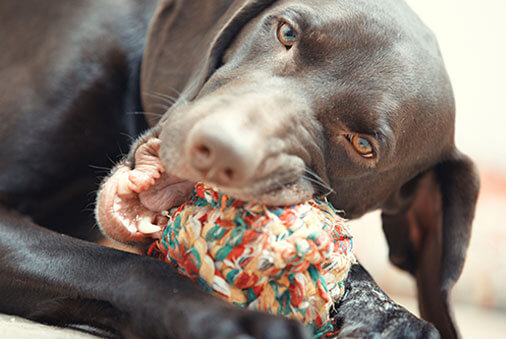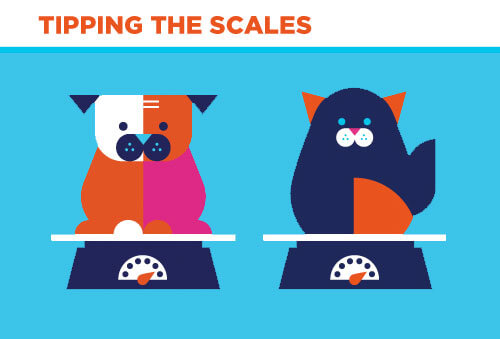Physical exercise for dogs
Most dog breeds were originally created to perform a specific job — retrieving, herding, tracking, hunting, guarding, rescuing, and pulling carts or sleds. So the urge to work is in their DNA. But these days, most dogs kept as pets don't have a job to do. In fact, with family members gone at work or school for hours, dogs are in danger of being understimulated. That's why some dogs resort to activities like excessive barking, chewing and hyperactivity, and why many trainers say that a tired dog is a good dog. The bottom line is, if you don't want your dog to be wired, get him tired.
Choosing the right exercise
The type and amount of exercise you choose for your dog will depend on many factors. His size and weight are important, of course, but so is his genetic makeup. If you have a dog with short legs, like a dachshund, you won't want to take him on a run with you.
The same is true of short-snouted dogs, like bulldogs, who may have trouble breathing during vigorous exercise and in hotter temps. Even dogs bred for racing, like Greyhounds, were never meant for extended sessions. Dogs tend to run in short bursts, stopping to sniff, greet other dogs, and do the things that dogs do. To be safe, consult with your veterinarian before embarking on a running program. And if you do start, be consistent. Dogs don't fare any better as weekend warriors than people do.
Go fetch!
There are plenty of other activities that can give your dog a good workout and enable you both to have fun. Fetch is a big favorite, and can be played with balls outside and plush toys in the house.
Another great sport is frisbee because it requires your dog to anticipate how far the frisbee will go — an excellent mental exercise. Here's how to teach your dog to catch a frisbee:
- Start with a disc designed for dogs. (You can find these from Hyperflite, Hero or Aerobie.)
- Offer the frisbee to your dog and praise him when he takes it from you.
- Play tug of war gently and let your dog win.
- Roll the disc on the ground and encourage your dog to retrieve it.
- When you feel your dog is used to and interested in the frisbee, throw it a few feet way — but never at your dog's face. Praise him when he catches it and never show anger or frustration.
In no time, you'll be playing frisbee regularly.
Just for kicks
Another physical activity that's fun for both pets and humans is soccer. Use a medium sized ball or a hard rubber toy like Kong® that bounces in unpredictable directions. If your dog is social, you can bring him to a dog park (choose one that is securely fenced) and let him play with other dogs. This can be good for physical and mental stimulation.
Dive in!
Some dogs are natural swimmers. Others can be taught. If your dog shows fear or lack of interest, don't force him. Some breeds, like short, heavily built dogs (think basset hounds) are nonswimmers. But if your dog takes to water like a duck, swimming or playing fetch in the water is a great aerobic activity. Some dogs even go surfing!
Mental exercise for dogs
In addition to providing challenges to help keep your dog alert and happy, mental activities are a great way to bond with your pet. Dogs thrive on attention, and you may even find your dog returning the favor by being more attentive to your commands. One thing's for sure — you'll both have fun.
Make mealtime even more fun
Turn one of your dog's favorite times of the day (especially if you're feeding him BLUE) into a treasure hunt. Surprise him by putting his food bowl in an unexpected place and creating a kibble trail. Just be sure to account for the kibble trail in his overall daily food amount so he doesn't gain unwanted weight. If your dog is particularly good at tracking, you can vary this by placing small amounts of kibble in different areas around the house.
Tug of war
Some dog books advise pet owners not to play tug of war for fear it will encourage aggression and dominance in your dog. While recent research suggests this is not true, it's always best to let your dog know that you control the game.
- Choose an appropriate toy (never a sock or a leash) and use it exclusively for this game.
- Start by letting your dog know you're playing "tug," pick up the toy, and encourage your dog to take his end. When he does, give him praise or a treat.
- Tug a few times, then use a neutral command voice when you want him to "drop it."
- If your dog initiates the game, don't play. Wait until he gives up, then play with him. If he grabs the toy, end the game.
- Once you are playing successfully, you decide when the game ends. Reward his last "drop it" and put the toy away where he can't find it.
Name that toy
Each time you play with a certain toy, name it. Once your dog is familiar with the names of all his toys, put them on the floor and ask him for each toy by name. When he brings you the wrong toy, repeat the name and guide him to it. When he brings you the right toy, praise him and place it in his toy basket. Eventually, your dog may be able to put his toys away!
Tricks 'n' treats
There's no magic to teaching your dog to give you his paw, roll over, and perform other classic dog tricks. Just remember to reward him with treats and praise. Start by showing him what you want him to do, like shaking your hand. Take his paw while saying "shake," hold it, offer praise, let go, and repeat several times a day. For "roll over," begin with the dog when he's lying down, hold a treat to his nose, then move it around behind him so he lies on his side and then rolls over. When he does, give him the treat. Mental exercises like these not only keep your dog's mind agile, they can help him be more obedient, too. Be patient and consistent, and don't get frustrated or angry. The point is to engage your dog in a mental activity, not to create stress — for either of you.
Physical exercise for cats
Cats need exercise just like dogs do, but you probably won't have much luck getting your cat to run or play fetch with you. Instead, cats tend to get their exercise from day-to-day routines like walking to their food bowl and litter box, jumping onto their favorite perch, and playing. You can tap into these regular activities to help your cat get more exercise from them.
Space out your layout
If your cat's food and water bowls are right next to each other, try spreading them further apart to force her to do a little more walking. And keep the litter box in a different area of the house.
The perfect perch
Establish a lookout which your cat can climb or jump to. Perhaps there's a bird feeder she can watch out the window, or the dog across the street. If you don't have a cat tree, consider getting one. It will help improve your cat's balance and coordination, require her to jump, and double as a scratching post, which will encourage stretching and tone her back and shoulder muscles. Be sure to praise your cat when she uses it — it's good for her and it can save your chair legs.
Mental exercise for cats
There's quite a bit of overlap between physical and mental exercise for cats, so you can frequently accomplish both with the same activity. When your cat is going after toys designed to mimic prey, like a feather on a pole or a catnip mouse, she's using her mind as well as her body. Anything that stimulates her to move is good, and games that require her to formulate calculations and strategies are even better.
Curiosity is good for your cat
If your cat enjoys a toy, don't let her have it all the time. To keep her interest level high, put the toy away when you and your cat have finished playing with it. Get a variety of toys and rotate them every few days. Cats have different types of personalities and interests, and the better you know your cat, the better able you'll be to choose toys she'll like.
Store-bought playthings
Many cats enjoy toys based on their natural predatory behavior. Feathers that dangle from a pole can be great fun for both you and your cat — especially if you let her win once in a while. Fur rodents are also a big favorite. And many cats find chasing a laser light impossible to resist, despite (or because of) its elusiveness.
Another way you can motivate your cat to get moving is to make her work for her food. Try giving her a toy that contains a hidden treat. You can also let her find her own treat by planting some oat grass in a pot, which may even prevent her from munching on your houseplants.
Homemade cat toys
You don't have to be particularly handy when it comes to creating your own toys to keep your cat busy. Simple items are often as much fun for her as more elaborate ones:
- Just about anything dangling from a fishing line (great for "batting practice")
- An empty film canister filled with small dried beans
- A crumpled piece of paper
- The lid from a plastic milk jug
These are all fine playthings for a cat. When you're an active participant, she'll like them even better.
Training your cat
Many people think cats can't be trained. While it's true that cats were bred to be independent pest hunters, and don't generally look for praise and attention as dogs do, they can be motivated to respond to commands. You'll need patience and very special, delicious treats.
To teach your cat to sit:
- Put a treat near her nose.
- When she sniffs it, slowly lift it from her nose to between her ears.
- Her eyes will follow the treat, forcing her head to move up and her rear to move down. As this is happening, say "sit."
- When her rump touches the floor, offer praise and the treat.
- Practice this consistently a few times a day, and don't get discouraged if it takes several weeks for your cat to sit on command.
Cats are capable of learning many of the same things dogs are taught. They just require a little more perseverance. And the result is beneficial for both of you.
While finding time for activities with your pet can be a challenge, it's important to give your four-legged family member a daily workout. You may be able to combine human and pet exercise with a brisk half-hour walk with your dog, or by tying your cat's batting toy onto a hand-weight. (Be sure to get the okay from your own doctor if you're just starting out.) We all need some kind of exercise. And who's better to work out with than your best friend?



